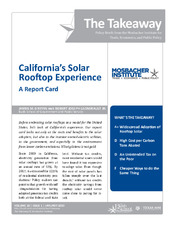| dc.creator | Griffin, James M. | |
| dc.creator | Ladmirault, Robert Joseph Jr | |
| dc.date.accessioned | 2019-01-24T17:05:05Z | |
| dc.date.available | 2019-01-24T17:05:05Z | |
| dc.date.issued | 2019-01 | |
| dc.identifier.uri | https://hdl.handle.net/1969.1/174636 | |
| dc.description | This policy brief evaluates California’s solar rooftop taking a broad look at the costs and benefits to California rooftop solar adopters, affected electric utility companies, the government, and to the environment from lower carbon emissions. Using data from academic and industry sources, the authors calculate how much would be spent on a rooftop solar system for a typical high-consumption residence in 2010, based on the fixed cost of the equipment, tax credits, and monthly solar savings. While allowing that California’s energy policies have resulted in a significant increase in the electricity produced by rooftop solar systems, the authors argue that California’s success came at a very high cost and that there are less expensive ways to achieve the same thing. The article recommends a carbon tax as the most cost-effective method for reducing carbon emissions. | en |
| dc.language.iso | en | |
| dc.publisher | Mosbacher Institute for Trade, Economics & Public Policy | |
| dc.relation.ispartofseries | Volume 10;Issue 1 | |
| dc.subject | rooftop solar | en |
| dc.subject | California | en |
| dc.subject | economic costs and benefits | en |
| dc.title | California’s Solar Rooftop Experience: A Report Card | en |
| dc.type | Article | en |
| dc.contributor.sponsor | Bush School of Government and Public Service | |
| local.department | Other | en |


